Physical Address
304 North Cardinal St.
Dorchester Center, MA 02124
Physical Address
304 North Cardinal St.
Dorchester Center, MA 02124
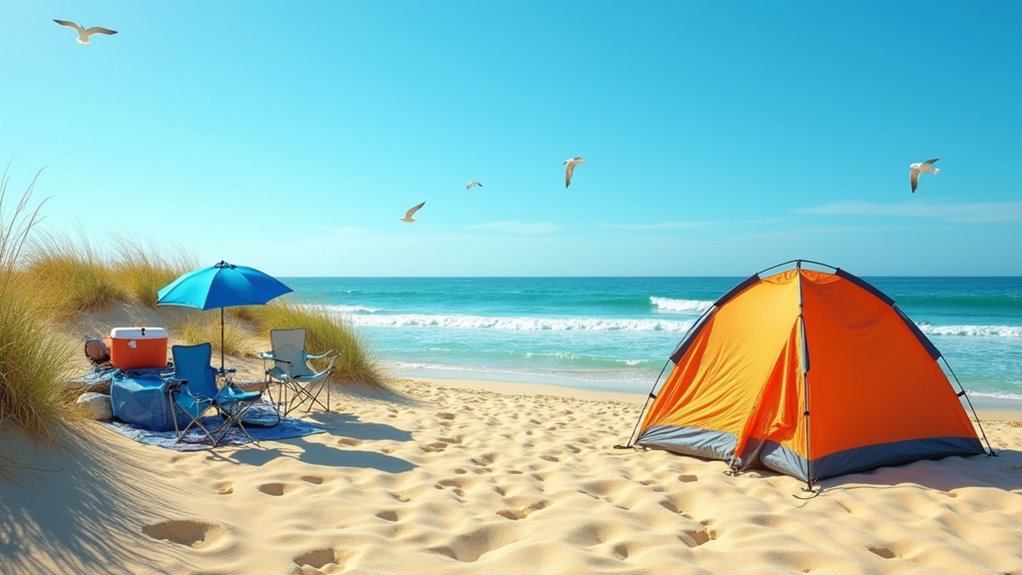
Want to avoid costly beach camping disasters while mastering the coastal challenges that separate novice campers from seasoned pros?
You’ve probably heard that beach tent camping is just regular camping with sand, but that theory couldn’t be more wrong. The coastal environment presents unique challenges that’ll make or break your trip – from unpredictable tides that can flood your campsite to relentless winds that’ll turn your tent into a kite. Master these beach-specific strategies, and you’ll discover why seasoned campers consider coastal camping the ultimate outdoor experience that won’t drain your wallet.
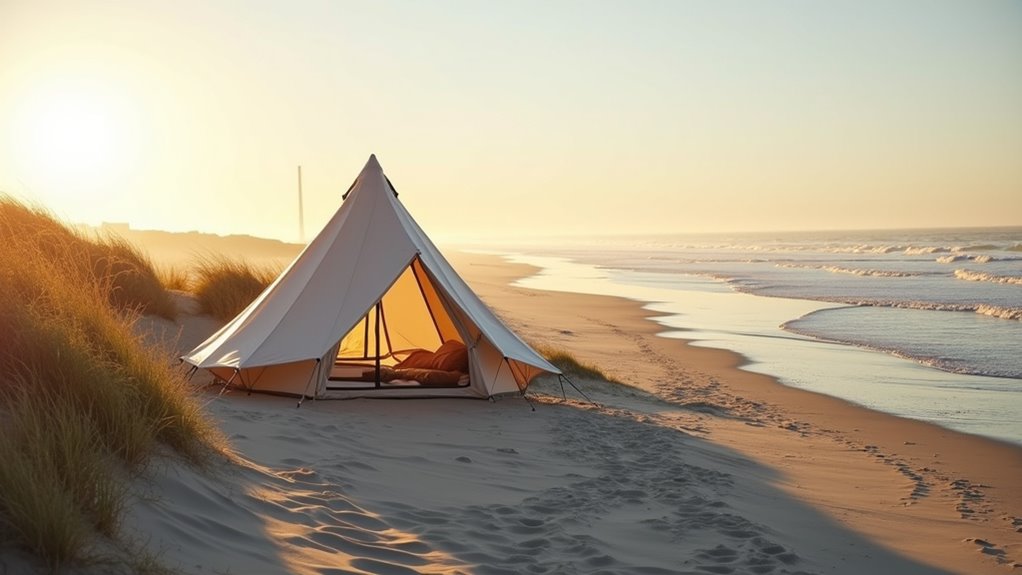
When you’re scouting for the ideal beachfront campsite, you’ll want to balance three key factors: proximity to the water, wind protection, and legal camping access.
Check local regulations first—many beaches prohibit overnight camping or require permits. Apps like Campendium and iOverlander help locate legal spots without hefty fees.
Position your tent 50-100 feet from high tide lines to avoid midnight surprises. Look for natural windbreaks like dunes, rocks, or vegetation. Strong ocean winds can destroy tents and ruin sleep.
Consider practical needs: parking access, restroom facilities, and fresh water sources. Remote spots offer privacy but may lack amenities.
Scout during different tide cycles if possible. What looks perfect at low tide might become problematic when waters rise. Always have backup locations identified.
Remember that responsible camping includes respecting the natural environment and following Leave No Trace principles to preserve these beautiful coastal areas for future campers.
Once you’ve secured your perfect beachfront spot, the right gear becomes your lifeline against sand, salt, and unpredictable coastal weather. You don’t need expensive equipment – just smart choices that’ll handle beach conditions.
Your tent should feature strong stakes for sandy ground and a robust rainfly for sudden storms. Pack extra tarps for ground protection and gear coverage. A quality cooler with tight seals keeps food fresh despite humidity, while mesh bags prevent sand from infiltrating everything.
Smart gear choices make the difference between beach camping success and sandy, soggy misery in unpredictable coastal conditions.
Essential coastal camping must-haves:
Focus on durability over luxury, and you’ll camp comfortably without breaking the bank. Consider taking a break from your tent occasionally to explore UK backpacking opportunities along the stunning British coastline.
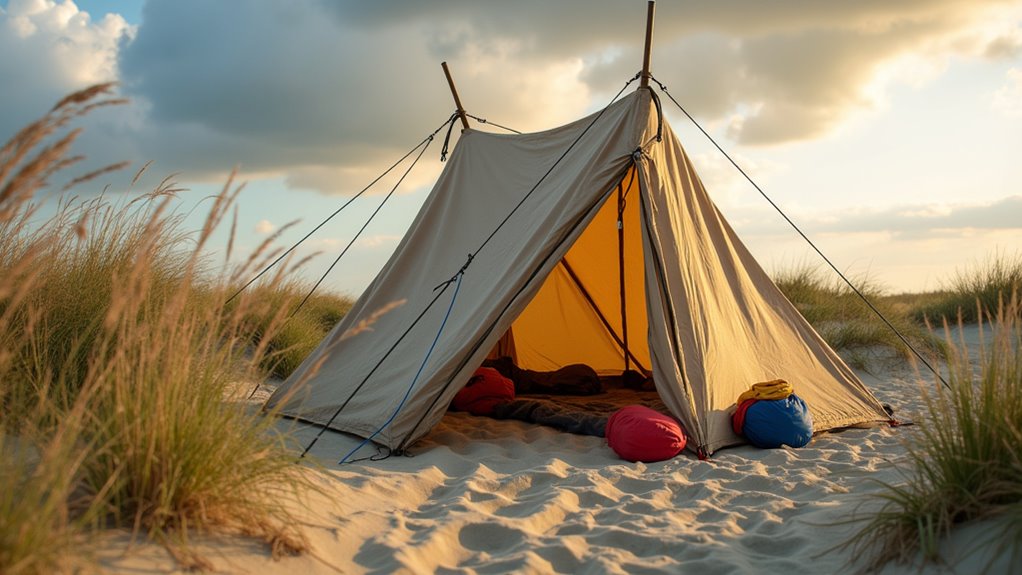
Coastal winds can turn your relaxing beach getaway into a tent-wrestling nightmare if you don’t anchor properly. You’ll need heavy-duty sand stakes or sand anchors instead of regular tent stakes that pull out easily. Drive them deep at 45-degree angles and use guy lines to create multiple anchor points.
Fill stuff sacks or pillowcases with sand to weigh down tent corners—it’s free ballast that works better than expensive weights. Position your tent’s smallest side facing prevailing winds to reduce resistance. Create windbreaks using tarps, beach umbrellas, or natural barriers like dunes.
Check weather forecasts religiously and don’t hesitate to relocate if conditions worsen. Pack everything inside your tent at night since coastal winds intensify after dark. These simple precautions prevent costly gear damage. Just like deciding whether to rent or buy watercraft for your beach activities, proper tent setup requires weighing the costs of preparation against potential equipment replacement.
Beyond keeping your tent anchored, sand and salt water pose constant threats to your electronics, clothing, and camping gear. You’ll need strategic protection to avoid costly replacements and frustrating mishaps.
Start by creating designated storage zones inside your tent. Use plastic bins with tight-fitting lids for electronics, medications, and dry clothes. Ziplock bags work perfectly for smaller items like phones and wallets – they’re cheap and effective.
Essential protection strategies include:
Remember that selecting the right camping shelter from the start will significantly impact how well your belongings stay protected throughout your beach camping adventure.
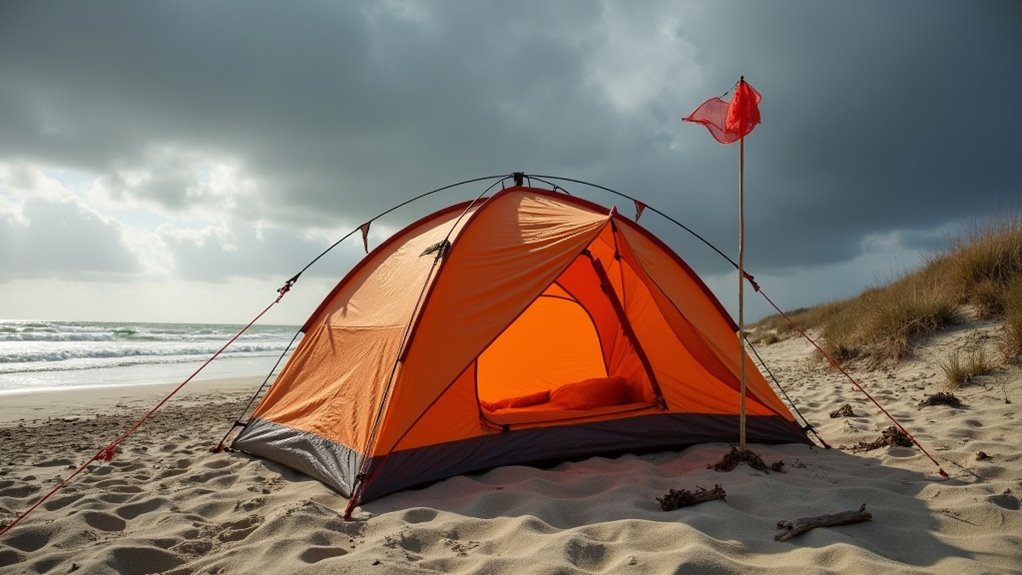
While protecting your gear matters, ignoring tide schedules and weather patterns can turn your beach camping trip into a dangerous situation. Check local tide charts before setting up camp – high tide can flood your campsite faster than you’d expect. Position your tent well above the high-tide line, adding extra distance for safety.
Monitor weather forecasts constantly. Coastal storms develop quickly and bring dangerous winds that’ll destroy your tent or worse. If thunderstorms approach, pack up immediately – beaches offer zero lightning protection.
Strong offshore winds can create deadly rip currents, making swimming unsafe.
Download free weather apps and bookmark local tide websites before your trip. These resources don’t cost anything but could save your life. When in doubt, relocate to higher ground.
Consider purchasing travel insurance that covers camping activities and weather-related trip interruptions, as coastal conditions can change rapidly and force unexpected plan changes.
Since sand gets into everything, you’ll want to plan meals that don’t require extensive prep or cleanup. Focus on simple, one-pot dishes and pre-prepped ingredients that won’t break your budget or create a mess.
Keep beach meals simple and mess-free with minimal prep to avoid sandy kitchen disasters and budget blowouts.
Smart beach cooking strategies include:
For quick and satisfying beach sandwiches, deli meats offer a convenient protein option that requires no cooking and minimal preparation time.
Bring a large cooler with plenty of ice, pack drinks separately from food, and always store everything in sealed containers. You’ll save money and avoid sandy disasters.
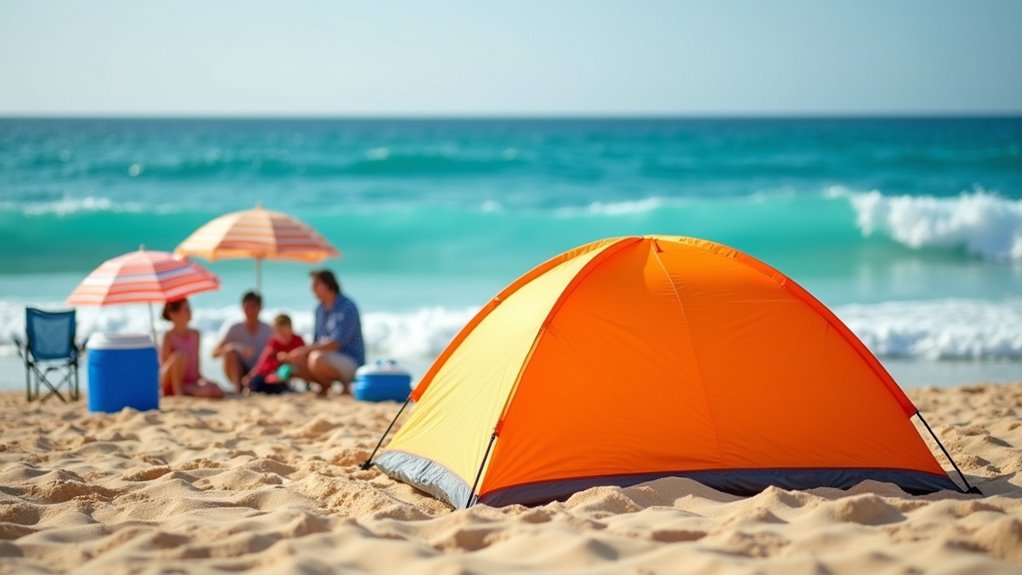
After you’ve got your meals sorted, you’ll want to plan some fun activities that take advantage of your beachfront location without breaking the bank. Start with classic beach games like frisbee, volleyball, or sandcastle building—these require minimal equipment but provide hours of entertainment.
Collect shells, sea glass, or interesting rocks for free souvenirs. During calm evenings, try stargazing or telling stories around a small lantern. Pack cards, travel board games, or books for quieter moments. Don’t forget a good playlist and portable speaker for beach vibes.
Consider tide pooling if rocky areas are nearby, or simply enjoy long beach walks during sunrise or sunset when the crowds thin out. Take advantage of the ocean by trying exciting water activities like swimming, snorkeling, or kayaking to make your beach camping experience even more memorable.
Before you know it, your beach camping adventure will come to an end, and proper planning makes the difference between a smooth departure and a stressful scramble. Don’t let post-vacation stress ruin your final moments of beach bliss.
Start packing the night before your departure. Roll up sleeping bags while they’re still dry, and stuff clothes into compression sacks. You’ll save precious morning time and avoid the dreaded wet-gear dilemma.
Essential packing and cleanup strategies:
Proper dish-cleaning techniques during your camping trip will make your final cleanup much more manageable and ensure you leave no trace behind.
You’ll join the 41% of campers who return to beach camping annually once you’ve mastered these techniques. Don’t let initial challenges discourage you – with proper planning and gear organization, you’re setting yourself up for countless memorable coastal adventures. Remember, beach camping doesn’t require expensive equipment; smart preparation beats costly gear every time. Start with your first trip using these budget-friendly strategies, and you’ll discover why beach tent camping becomes addictive for so many outdoor enthusiasts.